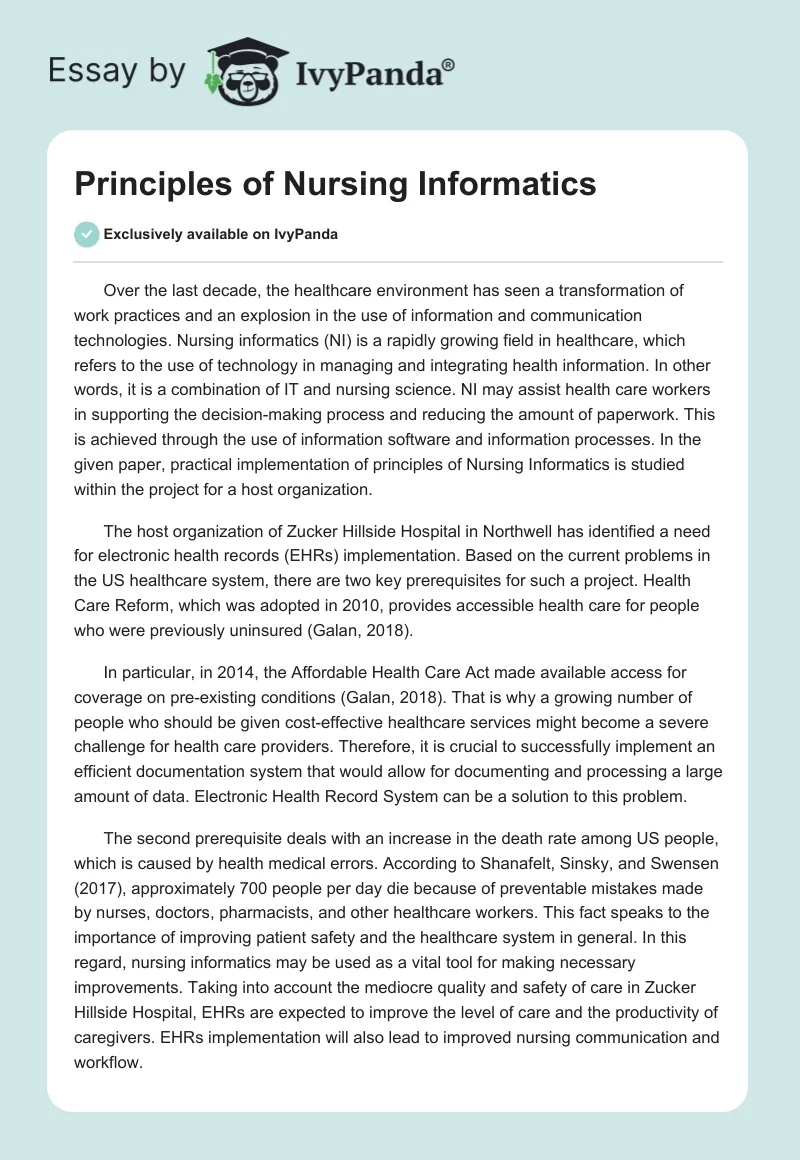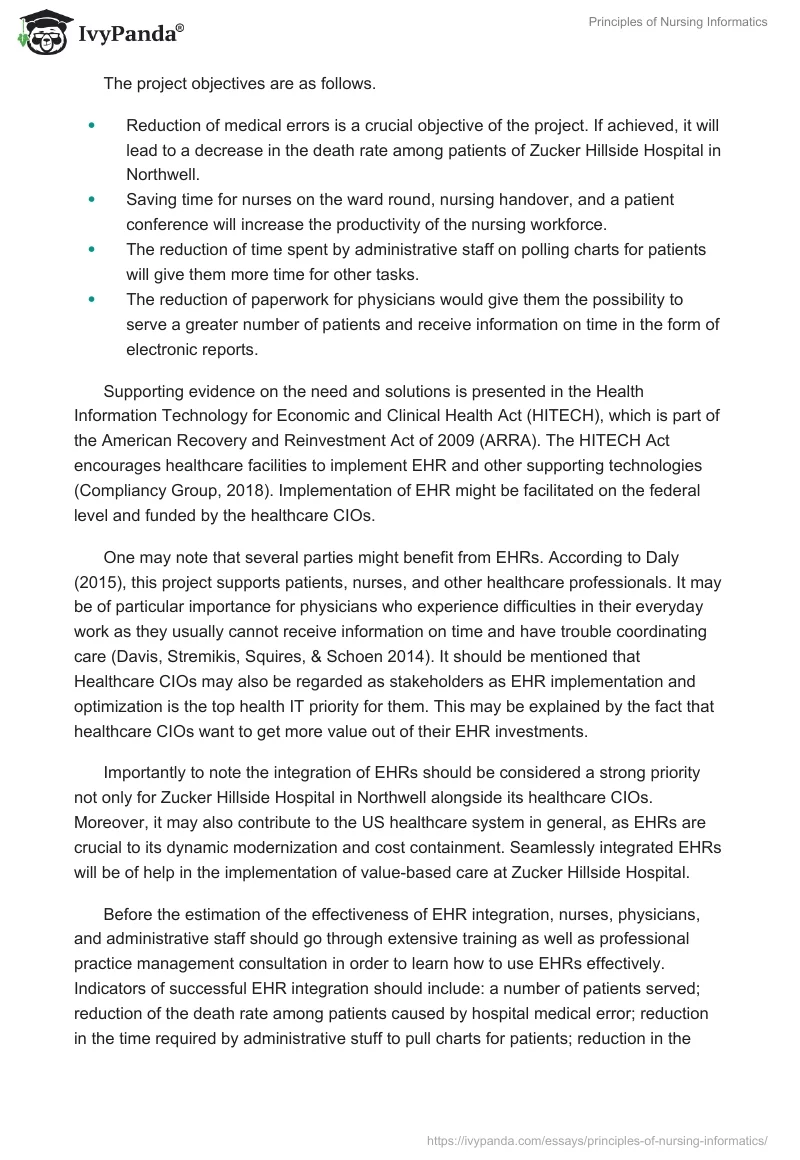Over the last decade, the healthcare environment has seen a transformation of work practices and an explosion in the use of information and communication technologies. Nursing informatics (NI) is a rapidly growing field in healthcare, which refers to the use of technology in managing and integrating health information. In other words, it is a combination of IT and nursing science. NI may assist health care workers in supporting the decision-making process and reducing the amount of paperwork. This is achieved through the use of information software and information processes. In the given paper, practical implementation of principles of Nursing Informatics is studied within the project for a host organization.
The host organization of Zucker Hillside Hospital in Northwell has identified a need for electronic health records (EHRs) implementation. Based on the current problems in the US healthcare system, there are two key prerequisites for such a project. Health Care Reform, which was adopted in 2010, provides accessible health care for people who were previously uninsured (Galan, 2018).
In particular, in 2014, the Affordable Health Care Act made available access for coverage on pre-existing conditions (Galan, 2018). That is why a growing number of people who should be given cost-effective healthcare services might become a severe challenge for health care providers. Therefore, it is crucial to successfully implement an efficient documentation system that would allow for documenting and processing a large amount of data. Electronic Health Record System can be a solution to this problem.
The second prerequisite deals with an increase in the death rate among US people, which is caused by health medical errors. According to Shanafelt, Sinsky, and Swensen (2017), approximately 700 people per day die because of preventable mistakes made by nurses, doctors, pharmacists, and other healthcare workers. This fact speaks to the importance of improving patient safety and the healthcare system in general. In this regard, nursing informatics may be used as a vital tool for making necessary improvements. Taking into account the mediocre quality and safety of care in Zucker Hillside Hospital, EHRs are expected to improve the level of care and the productivity of caregivers. EHRs implementation will also lead to improved nursing communication and workflow.
The project objectives are as follows.
- Reduction of medical errors is a crucial objective of the project. If achieved, it will lead to a decrease in the death rate among patients of Zucker Hillside Hospital in Northwell.
- Saving time for nurses on the ward round, nursing handover, and a patient conference will increase the productivity of the nursing workforce.
- The reduction of time spent by administrative staff on polling charts for patients will give them more time for other tasks.
- The reduction of paperwork for physicians would give them the possibility to serve a greater number of patients and receive information on time in the form of electronic reports.
Supporting evidence on the need and solutions is presented in the Health Information Technology for Economic and Clinical Health Act (HITECH), which is part of the American Recovery and Reinvestment Act of 2009 (ARRA). The HITECH Act encourages healthcare facilities to implement EHR and other supporting technologies (Compliancy Group, 2018). Implementation of EHR might be facilitated on the federal level and funded by the healthcare CIOs.
One may note that several parties might benefit from EHRs. According to Daly (2015), this project supports patients, nurses, and other healthcare professionals. It may be of particular importance for physicians who experience difficulties in their everyday work as they usually cannot receive information on time and have trouble coordinating care (Davis, Stremikis, Squires, & Schoen 2014). It should be mentioned that Healthcare CIOs may also be regarded as stakeholders as EHR implementation and optimization is the top health IT priority for them. This may be explained by the fact that healthcare CIOs want to get more value out of their EHR investments.
Importantly to note the integration of EHRs should be considered a strong priority not only for Zucker Hillside Hospital in Northwell alongside its healthcare CIOs. Moreover, it may also contribute to the US healthcare system in general, as EHRs are crucial to its dynamic modernization and cost containment. Seamlessly integrated EHRs will be of help in the implementation of value-based care at Zucker Hillside Hospital.
Before the estimation of the effectiveness of EHR integration, nurses, physicians, and administrative staff should go through extensive training as well as professional practice management consultation in order to learn how to use EHRs effectively. Indicators of successful EHR integration should include: a number of patients served; reduction of the death rate among patients caused by hospital medical error; reduction in the time required by administrative stuff to pull charts for patients; reduction in the time spent on a ward round, nursing handover and patient conferences (Weiner, Fowles, & Chan, 2012).
Measurements of these indicators may be acquired using various techniques including questionnaires, interviews, observations, official statistical data, and TLX rates before and after 6 and 18 months of EHR implementation.
Variables regarding administrative staff, which should be measured within the survey, should include time spent on pulling charts for filling lab results and writing in the chart, doing billing tasks, and preparing day sheets. The staff of the organization should be asked on the amount of time which they spent working in and out of office; consistency of the reconciliation process; whether the documentation was acquired on time.
Measuring variables regarding the physicians’ use of EHR may include: time spent writing in the chart, lab report review, time on viewing the paper documents; script writing and renewals; consult reports review. Physicians and nurses should be asked if they were spending more time writing charts, had less work to do during the day and whether the number of patients changed (Weiner, Fowles, & Chan, 2012). Some variables, such as time which a physician needs to make an observation, should be directly measured.
Data from the project should be comparatively analyzed by means of the TLX scores. The success of the project should be estimated on the basis of measurable indicators. If there is a positive difference between post-EHR variables and pre-EHR variables, the project might be considered to be successful. However, it should be noted that variables which are not expected to change should be identified as controllers.
The results of the project should be reported to the mentor who is a team member for the project. Formal results on the EHR implementation should be given to the healthcare CIO and top management of the host organization of Zucker Hillside Hospital in Northwell. The results should include a list of objectives and a detailed survey with a list of all pre-EHR and post-EHR variables. Based on the survey, the conclusion regarding the outcome of the project should be made.
To sum up, nursing informatics is revolutionizing the way healthcare personnel may interact with health-related data. Computerization of physician and nursing practicing is a key tool in improving the quality of healthcare system as well as the productivity of the inter-professional healthcare personnel. Generally speaking, EHR implementation is associated with a reduction in hospital medical errors and improved nursing documentation. In the given research, an outline for the project on EHR implementation for a host organization is provided along with methods for evaluation of the success.
References
Compliancy Group. (2018). What is the HITECH Act? Web.
Daly, P. (2015). Clinical nurses lead the charge with EHR. Nursing, 45(10), 25-26. Web.
Davis, K., Stremikis, K., Squires, D., & Schoen, C. (2014). Mirror, mirror on the wall, 2014 update: How the U.S. health care system compares internationally. Web.
Galan, N. (2018). The Affordable Care Act: Healthcare reform in the U.S. Web.
Shanafelt, T., Sinsky, C. A., & Swensen, S. (2017). Preventable deaths in American hospitals. Web.
Weiner, J. P., Fowles, J. B., & Chan, K. S. (2012). New paradigms for measuring clinical performance using electronic health records. International Journal for Quality in Health Care, 24(3), 200-205. Web.


